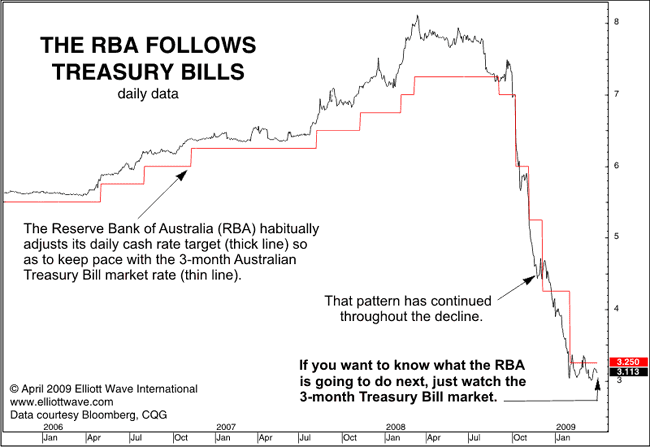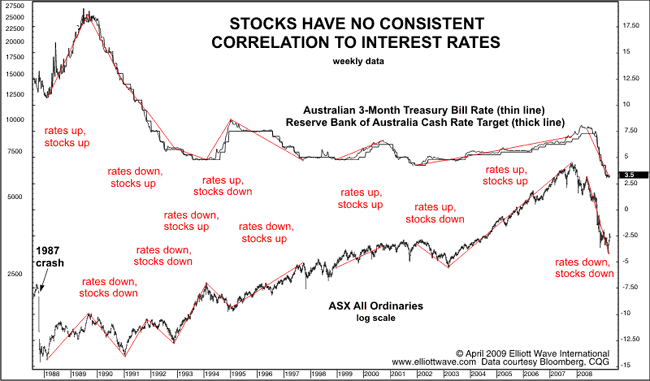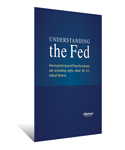Think That Central Banks Move the Markets? Think Again
By Mark Galasiewski
The following is excerpted from Elliott Wave International’s Global Market Perspective. The full 120-page publication, which features forecasts for every major world market, is available free until April 30. Visit Elliott Wave International to download it free.
Conventional wisdom says that central banks can influence or even direct financial markets and the macro economy. The very existence of Elliott waves challenges such assumptions. For if markets responded to every central bank directive, how could Elliott waves exist? Parallel trend channels, Fibonacci price relationships, the similarity of form between waves of different sizes and time periods—none of that would be possible. Central bank decisions would have to coincide perfectly with turning points in Elliott waves, and we know that just doesn’t happen. But even without using waves, we can expose the conventional wisdom for the fallacy that it is.
Take, for example, this assertion in a recent article in a U.K. economic weekly: “Part of the aim of central banks in driving down interest rates is to encourage a greater risk appetite among investors.” Two key assumptions underlie that statement: a) central banks determine interest rates; and b) lower interest rates can increase society’s appetite for risk.
To see how the first assumption is false, let’s take a look at the daily chart of Australian interest rate data. It duplicates a study that Elliott Wave International has often done with U.S. interest rate data. It shows how movements in the cash target rate set by Australia’s central bank, the Reserve Bank of Australia (RBA), appear to follow those in 3-month Australian Treasury Bills. After decisive moves up in T-bills from 2006 to early 2008, for example, the RBA faithfully raised its target. T-bills have since led the RBA during the financial crisis of the past year. In fact, the record indicates that the RBA almost always follows T-bills over time.
 |
The proper conclusion to draw is not that the RBA has orchestrated the decline in rates since the early 1980s—but that it’s been riding it. During good times, central bankers look like geniuses; during bad times, they get tarred and feathered. Closer to the truth is that their interest-rate decisions are not proactive, but reactive, and that they continually follow in the footsteps of the market for lack of any other useful guide.
Now let’s look at the second assumption: that lower interest rates increase society’s appetite for risk. A simple glance at the weekly chart shows this assumption to be false. After the 1987 crash, the ASX All Ordinaries actually rallied for two years on rising rates and then sold off through 1990 on falling rates. Stocks then rose in 1991 on continued falling rates and sold off in 1992 on even lower rates. Continue following the chart to the right and you will see that there is no consistent correlation between the direction of interest rates and that of the stock market.
 |
The myth of central bank potency is so pervasive that conventional analysts can’t even imagine a better explanation for price trends: that the market is the dog wagging its central bank tail, not the other way around.
For more information, download Elliott Wave International’s FREE issue of Global Market Perspective, available until April 30. The 120-page publication covers every major world market, global interest rates, international currencies, metals, energy and more.
Mark Galasiewski is the editor of Elliott Wave International’s Asian Financial Forecast and member of EWI’s Global Market Perspective team covering Asian stock indexes.
Understanding the Fed – Not Just the Myths About the Fed
April 6, 2010
By Editorial Staff
If you would like to understand more about how the U.S. Federal Reserve works, you can spend some time on its website — or you can get the real story. Elliott Wave International has collected eight of Robert Prechter’s most trenchant articles about what the Fed actually does. He takes on the misleading myths about the Fed and explains what’s really going on as he writes about these topics.
How the Fed manufactures money
- How the Fed encourages the growth of credit — and why that’s deflationary
- What gives the Fed the authority to bail out troubled institutions
- The difference between creating money and facilitating credit
- Whether the Fed can manipulate the stock market or economy
- How the Fed is ignoring historical lessons about central banks
- How the Fed’s actions, combined with public outrage, may ultimately lead to its demise
The eBook with eight chapters is called Understanding the Fed: How to protect yourself from the common and misleading myths about the U.S. Federal Reserve. Here’s an excerpt to give you a taste of what you will learn.
The Fed’s “Uncle” Point Is in View
Chapter 13 of Conquer the Crash is titled, “Can the Fed Stop Deflation?” The answer given there was an emphatic no. In barely a year the faith –and that’s what it was–in the Fed’s inflating power has pretty much died. Conquer the Crash quoted The Wizard of Oz, and now anyone can see that there is no magic: just a man yanking on levers and blowing smoke. Back in 1929, consortiums of big banks, using their depositors’ money, tried to save the debt-laden stock market. They failed. This time, the new consortium was bigger: the Federal Reserve. But Conquer the Crash anticipated the end of that game, too: “The bankers’ pools of 1929 gave up on this strategy, and so will the Fed if it tries it.”
It is finally becoming obvious to everyone that the Fed is failing in extending its bag of tricks to stop deflation. The Fed’s balance sheet now contains more than 50 percent mortgage and other bank debt. Perhaps the Fed is willing to blow the rest of its AAA assets in the form of Treasury bonds, but somewhere between now and then is the Fed’s uncle point. The markets, however, are not so dumb as to wait for it. They can already see the end of that road, and they are moving now, ahead of it.
The Last Bastion against Deflation: The Federal Government
Now that the downward portion of the credit cycle is firmly in force, further inflation is impossible. But there is one entity left that can try to stave off deflation: the federal government.
The ultimate source of all the bad credit in the U.S. financial system is Congress. Congress created the Federal Reserve System and many privileged lending corporations: Fannie Mae, Freddie Mac, Ginnie Mae, Sallie Mae, the Federal Housing Administration and the Federal Home Loan Banks, to name a few. The August 2008 issue cited our estimate that the mortgage-encouraging entities that Congress created account for 75 percent of all U.S. debt creation with respect to housing. For investors in mortgage (in)securities, the ratio is even greater. Recent reports show that these agencies, which have been stealing people blind by taking interest for nothing, account for a stunning 82 percent of all securitized mortgage debt. Roughly speaking, the government directly encouraged the indebtedness of four out of five home-related borrowers. As noted in the August issue, it indirectly encouraged the rest through the Fed’s lending to banks and the FDIC’s guarantee of bank deposits. These policies allowed borrowers to drive up house prices to absurd levels, making them unaffordable to people who wanted to buy them with actual money. Proof that these mortgages are artificial and the product of something other than a free market is the fact that while Germany, for example, has issued mortgage-backed securities with a value equal to 0.2 percent of its annual GDP, the U.S. has issued them so ferociously that their value has reached 49.6 percent of annual GDP, a multiple of 250 times Germany’s rate, and that is not in total value but only in value relative to the U.S.’s much larger GDP. (Statistics courtesy of the British Treasury.)
|
Well, the ultimate source of this seemingly risk-free credit still exists, at least for now. When Bernake & Co. met in the back rooms of the White House in recent weekends, he must have said this: “Boys, we’re nearly out of ammo. We have $400b. of credit left to lend, and we have two percentage points lower to go in interest rates. The only way to stave of deflation is for you to guarantee all the bad debts in the system.” So far, government has leapt to oblige. One of its representatives strode to the podium to declare that it would pledge the future production of the American taxpayer in order to trade, in essence, all the bad IOUs held by speculators in Fannie and Freddie’s mortgages for gilt-edged, freshly stamped U.S. Treasury bonds.
Now, what exactly does that mean for deflation? This latest extension of the decades-long debt-creation scheme has essentially exchanged bad IOUs for T-bonds. This move does not create inflation, but it is an attempt to stop deflation. Instead of becoming worthless wallpaper and 20-cents-on-the-dollar pieces of paper, these IOUs have, through the flap of a jaw, maintained their full, 100 percent liability. This means that the credit supply attending all these mortgages, which was in the process of collapsing, has ballooned right back up to its former level.
You might think this shift of liability is a magic potion to stave off deflation. But it’s not.
Believers in perpetual inflation will ask, “What’s to stop this U.S. government from simply adopting all bad debts, keeping the credit bubble inflated?” Answer: The U.S. government’s IOUs have a price, an interest rate and a safety rating. Just as mortgage prices, rates and safety ratings were under investors’ control, so they are for Treasuries. Remember when Bill Clinton became outraged when he found out that “a bunch of bond traders,” not politicians determined the price of T-bonds and the interest rates that the government must charge? If investors begin to fear the government’s ability to pay interest and principal, they will move out of Treasuries the way they moved out of mortgages. The American financial system is too soaked with bad debt for a government bailout to work, and the market won’t let politicians get away with assuming all the bad debts. It may take some time for the market to figure out what to do about it, but as always, there is no such thing as a free lunch. The only question is who pays for it.
The Fed is nearly out of the picture, so the consortium of last resort, the federal government, is assuming the job of propping up the debt bubble. It is multiples bigger than any such entity that went before, because it can draw on the liquidity of American taxpayers and clandestinely steal value from American savers. So the question comes down to this: Will the public put up with more financial exploitation? To date, that’s exactly what it has done, but social mood has entered wave c of a Supercycle-degree decline, and voters are likely to become far less complacent, and more belligerent, than they have been for the past 76 years.
An early hint of the public’s reaction comes in the form of news reports. In my lifetime, I can hardly remember times when the media questioned benevolent-sounding actions of the government. Articles were always about who the action would “help.” But many commentators have more accurately reported on the latest bailout. USA Today’s headline reads, “Taxpayers take on trillions of risk.” (9/8) This headline is stunning because of its accuracy. When the government bailed out Chrysler, no newspaper ran an equally accurate headline saying, “Congress assures long-run bankruptcy for GM and Ford.” They all talked about why it was a good thing. This time, realism and skepticism (at a later stage of the cycle it will be cynicism and outrage) attend the bailout. The Wall Street Journal’s “Market Watch” reports an overwhelmingly negative response among emailers. Local newspapers’ “Letters” sections publish comments of dismay and even outrage. CNBC’s Mark Haines, in an interview on 9/8 with MSNBC, began by saying ironically, “Isn’t socialism great?” This breadth of disgust is new, and it’s a reflection of emerging negative social mood.
Social mood trends arise from mental states and lead to social actions and events. Deflation is a social event. Ultimately, social mood will determine whether deflation occurs or not. When voters become angry enough, Congressmen will stop flinging pork at all comers. Now the automakers want a bailout. Voters have remained complacent about it so far, but this benign attitude won’t last. The day the government capitulates and announces that it can’t bail out everyone is the day deflationary psychology will have won out.
|
Elliott Wave International (EWI) is the world’s largest market forecasting firm. EWI’s 20-plus analysts provide around-the-clock forecasts of every major market in the world via the internet and proprietary web systems like Reuters and Bloomberg. EWI’s educational services include conferences, workshops, webinars, video tapes, special reports, books and one of the internet’s richest free content programs, Club EWI.
Behind Closed Doors at the Federal Reserve
Ten Years of Research into America’s Central Bank
During the past few years, The Federal Reserve has engaged in a “deliberate inflating policy.”
This policy earned disfavor, both at home and abroad.
Robert Prechter said this in the July Elliott Wave Theorist:
“Foreign powers have been irate over the Fed’s deliberate inflating policy. At its outset, QE2 generated ‘a chorus of criticism’ from China, Russia, Japan, Brazil and Germany. It prompted one of China’s three credit rating services to lower its rating on U.S. debt from AA to A+, on the basis that QE2 is a scheme to defraud the Treasury’s creditors.
(Inflation is a scheme to rob everyone.) Whether or not that rating decision was politically motivated, it represents foreign resistance to the Fed’s machinations.”
[Note: The credit rating service in China is not alone in downgrading U.S. debt. History was made August 5 when Standard & Poor’s downgraded the United States’ credit rating from AAA to AA+.]
External resistance to the Fed’s policies is one thing. But the machinations of America’s central bank are also encountering resistance from within the Fed itself, albeit “behind closed doors.” Let’s return to the July Theorist:
It is not just outsiders who criticize the Fed’s policies. Kansas City Federal Reserve Bank President Thomas Hoenig voted against all seven of the Fed’s policy decisions in 2010. He disagreed with QE2 on the basis that it would generate inflation. He went public with his views at a Republican meeting in Washington on December 2. Richmond Fed President Jeffrey Lacker and Philadelphia Fed President Charles Plosser have also expressed concerns. Even Kevin Warsh, at that time a Fed governor-at-large who had never failed to support Bernanke, in a New York speech “warned of ‘significant risks’ associated with the program” (AP, 11/9) and expressed doubt that it would help the economy at all. His op-ed piece for The New York Times “expressed deep skepticism” of the plan. Richard Fisher, president of the Dallas Fed, in a San Antonio speech called QE2 the “wrong medicine” for the economy.
The “wrong medicine” indeed! If anything, the economy seems as unhealthy now as it was before QE2.
In a June 30 CNBC interview, former Fed Chairman Alan Greenspan himself said, “There is no evidence that [the] huge inflow of money into the system basically worked.”
|
 Prechter has extensively studied and written about the Fed for more than a decade. He has “pulled back the curtain” on the nation’s “lender of last resort” and his findings are more relevant today than ever.
Prechter has extensively studied and written about the Fed for more than a decade. He has “pulled back the curtain” on the nation’s “lender of last resort” and his findings are more relevant today than ever.